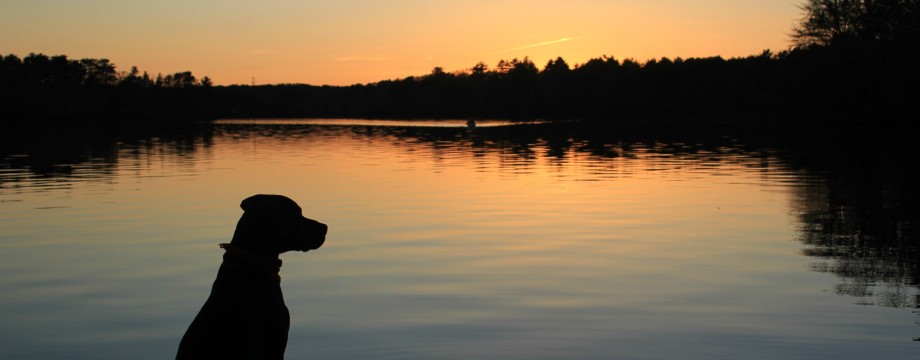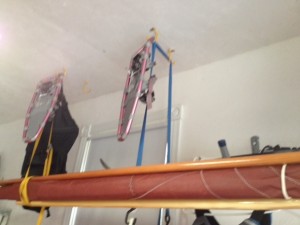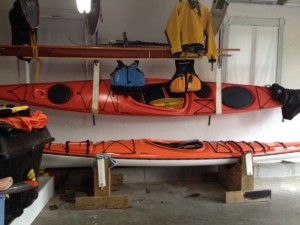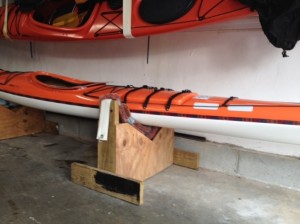For the past twenty-plus years, I have stored my roto-molded and composite kayaks inside my garage. In coastal New England, the summers can reach 100 degrees Fahrenheit and in the winters temperatures can easily fall overnight to -10 degrees Fahrenheit. I use 4” threaded screw-in “C-hooks” (aka. “screw hooks”) that I screw into pre-drilled holes in the floor joists that make up the attic floor above our heated garage. I had a local sail-maker fabricate 3 foot by 4 inch triple thickness straps with a grommet at each end that I use as hanging straps. These I attach to the “C-hooks” using woven straps with a simple hook that attaches to the grommets. Luckily the two windows behind my kayaks do not receive any direct sunlight. If this is a problem in your situation, you will need to problem solve a way to eliminate that heat source. (e.g.) 2” fitted panel of rigid foam insulation.
I also store my kayaks on edge with straps being about 1/3 of the way in fore and aft OR where the bulkheads are placed. My 17’ rotomolded sea kayak has a day hatch in addition to a front and rear hatch and a skeg box; so the aft end of the kayak it structurally more rigid that the foredeck. I will compensate and position the rear strap a little more towards the end of the kayak. I recognize that I am probably a bit more obsessive about structural integrity than most people so this is what I do throughout the off season. Once a month, I will rotate the kayaks about 1/3 of a turn so that they are making a 180 degree change from the cockpit opening facing into the garage to facing the wall. I will also adjust the straps 3 or 4 inches from side to side as I make these turns. I usually leave the hatch covers either loosely attached or I leave them off.
Have two sea kayaks to hang??
Unless you are an NFL Defensive Lineman who bench presses Volkswagens for laughs; you may find any kayak larger than 12’ to be awkward to manipulate at best. When you have two 17’ kayaks hanging by straps, one over the other; everything becomes more challenging due to their unwieldy length and the fact that you have garage wall 10” behind the kayaks. For maneuverability reasons, I would not hang my kayaks any closer than 8” from the wall of your garage.
A 60lb. sea kayak that is quite manageable to deadlift off the ground by the cockpit combing to thigh level; is quite different when the weight of that same kayak is stretched over its 17’ length and is now 4’ off the ground. One of the challenges is what to do with the stern of the kayak after unhooking the strap. Do you put something on the floor to rest it on; knowing that it will need to slide somewhat on the floor as you attempt to unhook the forward strap and/or slide the bow out of the loop formed by the forward strap? Scraping some plastic off of the stern of a RM kayak, while undesirable; is less of a problem than scraping off gelcoat from your composite kayak.
Another challenge is when you need to take down the upper kayak and you do not want to have to first take out the lower kayak. Here the problem is not simply that it is higher off of the ground and that you are exposing your shoulder to a greater risk of injury; but that you now have a set of straps hanging down that hold the lower kayak and you still have that unforgiving garage wall limiting your maneuverability. You have the additional problem of needing to rest the stern of the upper kayak that you have just unhooked on top of the swaying deck of the lower kayak and hope that it does not fall to the left or right of that kayak.
Now imagine yourself after a tiring day on the water. First you place the bow of the kayak into the attached loop formed by the front hanging strap. Now you need to pick up and hold the stern end of your 60lb kayak in the crook of your right arm while your left hand is trying to loop the grommeted end of the sailcloth strap over the swaying “C-hook” located at the end of the hanging woven strap. Not my definition of having great fun!!
After several years of sore muscles and some inevitable mishaps and more than a few well-chosen phrases; I decided to build cradles for my more frequently used lower kayak for three reasons. First, it eliminated the problem of a second set of straps hanging down when attempting to take down or put up the upper kayak. Secondly, it made is so much easier to lift a kayak out of low cradles without the bother of having to hook and unhook fore and aft straps. Third, when the kayak in the cradles is facing cockpit up you have created a stable non-swaying relatively flat plane upon which you can lower the upper kayak. I will place a rudder bath mat on the unmoving and more stable rear deck of the lower kayak; upon which the upper kayak will subsequently rest. There are two good reasons for doing this. First, it keeps the gel coat from being scratched. Second it reduces the chance of the upper kayak slipping off the lower kayak.
Building a set of cradles is quite simple. These rough dimensions worked for me and you may want to make your own adaptations. Refer to attached photo of cradles. Here is what you need: (2) 8’ 2X6 pressure treated framing lumber; a box of 1 ½” deck screws and one 4’X4’ piece of ½” plywood; (4) 2” threaded screw hook and (2) 3’X 4” sailcloth straps.
Cut the pressure treated 2X6 lumber into 2’ lengths for the supporting feet and into 2’ lengths for the upright legs of the cradles. Cut the plywood into (4) 24” pieces with a “V” shape so that the suspended kayak hangs just above the “V” of the cutout plywood. Use the decking screws to anchor the legs to the plywood. Attach the threaded screw hooks to outside of the 4 legs about 2” from the top with the opening of the hook facing down. For composite kayaks, I will wrap an old bath mat (cloth on one side and rubber backing on the other side) with trusty old Duct Tape around the sailcloth straps; so the gel coat is not abraded by any roughness of the sail cloth and stitching. Depending on how quickly your kayak tapers towards bow and stern; you may need to place a small piece of wood or foam pipe insulation between the top of the upright leg and the attached sailcloth straps to purchase more distance between the kayak and the shape of the “V” cut.
Good luck in adapting these suggestions to your own needs
-Boreal Alvik






2 Responses to Boreal Alvik’s Kayak Storage Solution